Decades in the making, Solar Orbiter finally meets launcher at Cape Canaveral – Spaceflight Now
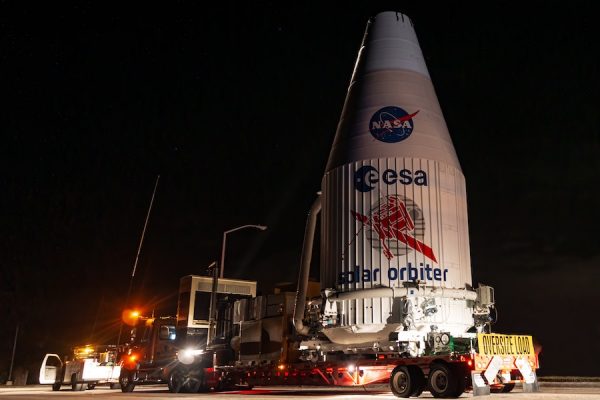
The European-built Solar Orbiter spacecraft was installed on top of its United Launch Alliance Atlas 5 launcher Friday at Cape Canaveral, ready for final charging and checkouts before liftoff Feb. 9 to finally begin a more than $1.5 billion science mission first approved by the European Space Agency nearly 20 years ago.
Scientists are eager for the unprecedented images and data Solar Orbiter will beam back to Earth, including the first-ever views of the sun’s poles.
“It will be terra incognita,” said Daniel Müller, project scientist for the mission at the European Space Agency. “This is really exploratory science.”
“The sun is an extremely dynamic astronomical body,” said César García, ESA’s project manager for the Solar Orbiter mission. “It’s constantly ejecting mass, ejecting charged particles and ejecting magnetic fields into where we are, into the heliosphere.
“The purpose of this mission is looking at these very dynamic phenomena, and trying to determine what makes them happen,” García said.
But it’s been a long wait. Scientists first developed the concept for the Solar Orbiter mission in 1999, and ESA approved the project in 2000 for additional studies. At that time, officials expected the mission to be ready for launch between 2008 and 2013.
After a decade of concept studies, and the start of a new partnership with NASA, ESA formally selected Solar Orbiter in 2011 for full-scale development, with a launch scheduled in 2017.
But technical difficulties in building the Solar Orbiter spacecraft delayed the mission to 2020.
The nearly 3,900-pound (1,750-kilogram) spacecraft was transferred by truck from the Astrotech payload processing facility in Titusville, Florida, early Friday and arrived at ULA’s Vertical Integration Facility at Cape Canaveral’s Complex 41 launch pad several hours later. Teams there hoisted the Solar Orbiter spacecraft — already enclosed inside its 4-meter (13.1-f0ot) payload shroud — atop an Atlas 5 launcher.
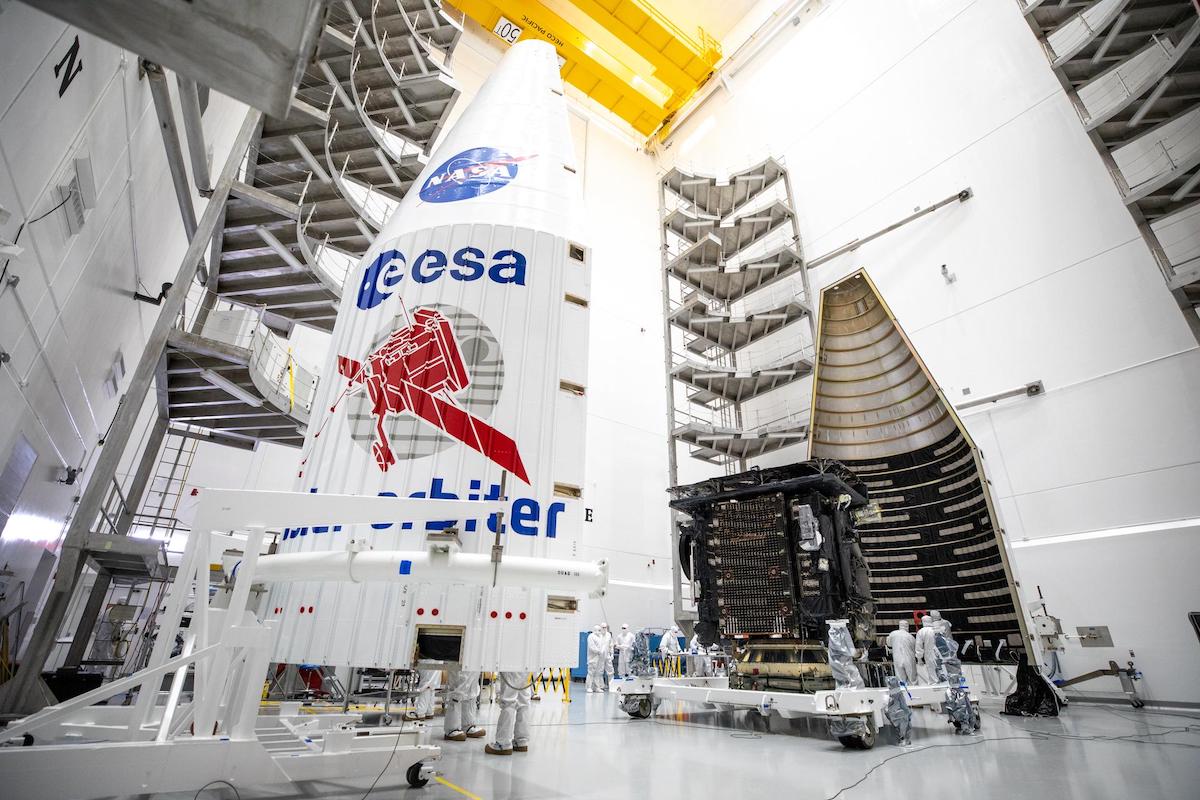
The Solar Orbiter spacecraft’s mating with its launch vehicle was delayed two days this week, first by a SpaceX launch from the nearby Complex 40 launch pad Wednesday, which prevented the payload transfer to the VIF due to safety concerns because of the close proximity between the pads. Poor weather Thursday prevented Solar Orbiter from rolling out to the VIF on Thursday, but conditions improved for the transfer operation Friday.
The delays in attaching Solar Orbiter to its Atlas 5 launcher forced officials to push back the mission’s liftoff from Feb. 7 to Feb. 9. The two-hour launch window Feb. 9 opens at 11:03 p.m. EST (0403 GMT on Feb. 10).
The launch was originally slated for Feb. 5, but a technical issue discovered during a practice countdown on the Atlas 5 rocket prompted a two-day schedule slip to Feb. 7.
Solar Orbiter has launch opportunities through Feb. 23, or else wait until a backup launch period in October. The mission has limited launch windows because it must depart Earth on a trajectory toward Venus, which plays a major role in reshaping Solar Orbiter’s trajectory around the sun to set it up for the start of its science mission.
Over the past few weeks, teams at Astrotech have loaded the Airbus-built spacecraft with a quarter-ton of hydrazine and nitrogen tetroxide propellants. Then technicians encapsulated the spacecraft inside the Atlas 5’s nose cone, which is emblazoned with logos for the Solar Orbiter mission, ESA and NASA.
While ESA leads the Solar Orbiter mission, NASA is paying for the probe’s launch, and there is one U.S.-led instrument on the spacecraft.
With the launch of Solar Orbiter, scientists will soon have two spacecraft observing the sun from locations closer than any previous mission.
NASA’s Parker Solar Probe launched in August 2018 on a trajectory that takes it closer to the sun than Solar Orbiter. But Solar Orbiter carries cameras and telescopes, while Parker flies so close to the sun that scorching temperatures could damage, or destroy, sensitive imaging sensors.
And Solar Orbiter will circle the sun at a higher tilt than Parker, allowing views of the sun’s poles.
“Solar Orbiter will go into a unique location moving out of the sun-Earth plane and be able to, for the first time, image the poles of the sun, so it’s adding a whole new dimension to what we’re able to do now,” said Nicky Fox, director of NASA’s heliophysics division.
The first good look at the sun’s poles will come in 2025, when Solar Orbiter reaches a trajectory angled at 17 degrees to the ecliptic plane, the plane in which the solar system’s planets are located. Repeated flybys with Venus will gradually ratchet up the probe’s inclination, or orbital tilt, thanks to the planet’s gravity.
By 2029, after the end of Solar Orbiter’s primary mission phase, the spacecraft should be in an orbit inclined more than 33 degrees to the ecliptic plane, enabling even better views of the sun’s poles.
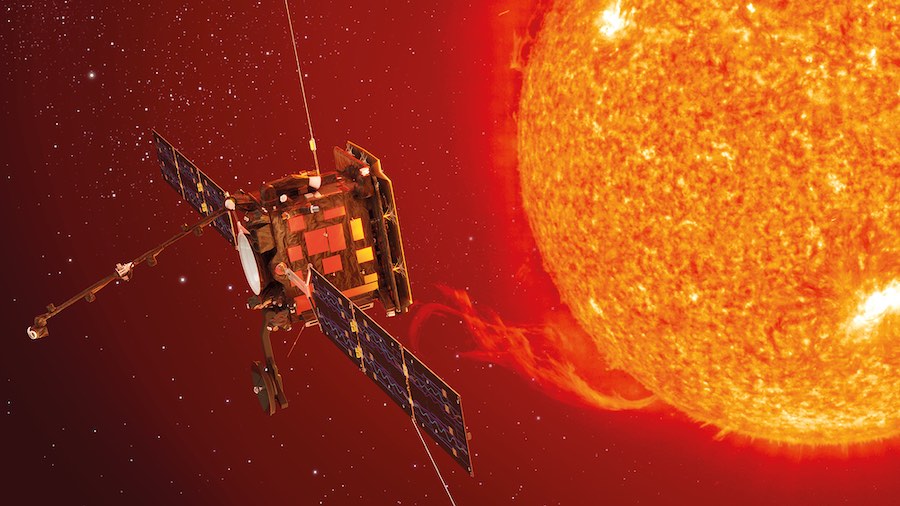
The Solar Orbiter mission, also known as SolO, is the next in a line of large-scale solar research mission developed in collaboration between the European Space Agency and NASA. It follows the Solar and Heliospheric Observatory, or SOHO, mission launched in 1995, and the Ulysses probe launched in 1990 to study the sun’s polar regions for the first time.
Ulysses ceased operating in 2009, but SOHO continues collecting data and imagery to measure the sun’s output and help forecasters predict the impacts of solar storms, which could affect satellite navigation, communication and electrical grids on Earth.
“SOHO has shown tremendous resilience and lifetime,” said Günther Hasinger, director of ESA’s science program. “SOHO is still one of the backbones of space weather prediction. At some time in the future, SOHO will no longer work. There was Ulysses originally, then SOHO. We also have a number of small missions like the Proba 2 and Proba 3 missions, which are dedicated to solar research.
“But Solar Orbiter is clearly a new class in its own,” Hasinger said in a recent interview with Spaceflight Now. “It has loads of instruments, which will go not as close as Parker Solar Probe, but quite close. Solar Orbiter will also have eyes. Parker Solar Probe can only sense and measure the plasma and the magnetic field, but Solar Orbiter also has six instruments that can really look at the sun.”
Fitted with 10 science instruments, Solar Orbiter will swing inside the orbit of Mercury and travel as close as 26 million miles (42 million kilometers) from the sun, about a quarter of Earth’s distance from the sun. Temperatures encountered by Solar Orbiter could reach nearly 1,000 degrees Fahrenheit, or about 530 degrees Celsius, according to Anne Pacros, Solar Orbiter’s mission and payload manager at ESA.
“It’s like being in a pizza oven, so you have to make sure that you don’t burn the instruments,” Hasinger said.
Solar Orbiter will see solar heating 13 times that experienced by a satellite in Earth orbit. Engineers developed a heat shield to protect the spacecraft from the hot temperatures, including sliding doors for the probe’s camera and telescopes.
The heat shield is made of several layers of titanium, the outermost of which is covered in a coating named “Solar Black,” which was specifically invented for the Solar Orbiter mission.
“We developed this black coating which is able to withstand about 500 degrees Celsius (more than 900 degrees Fahrenheit),” García said. “It is installed in a way that is separate from the spacecraft so that theres no conduction of heat from the very hot surface on the heat shield to the rest of the spacecraft.”
“The mission had three main requirements for the heat shield covering,” said Andrew Norman, an ESA materials engineer.
“Firstly, it had to keep the same colour during years of exposure to intense solar flux, including high ultraviolet radiation — the mission team would have loved a white coating, to reflect back more solar energy, but testing showed it would darken unacceptably over time,” Norman said in an ESA press release. “So we settled on black, to keep its thermo-optical properties stable over the mission lifetime.
“Secondly, it had to be electrically conductive, to prevent any build-up of static from interaction with the solar wind — which might do damage to the spacecraft by discharging,” Norman said. “Finally, there could be no outgassing or shedding of particles, which might endanger the mission’s instrument lenses, mirrors and sensitive surfaces.”
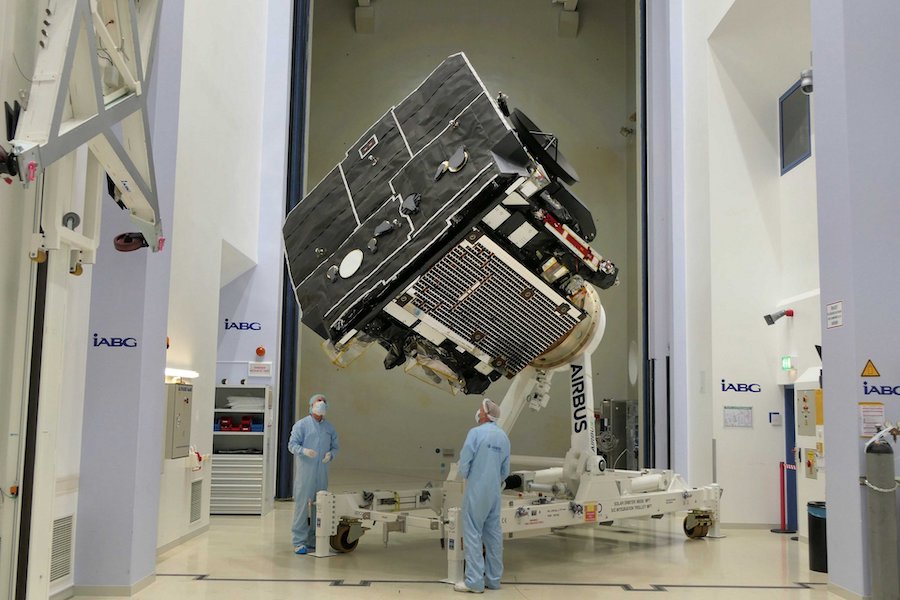
But existing paints and coatings could not satisfy all three requirements for the Solar Orbiter mission, and leaving the heat shield’s titanium structure bare was not a good option.
ESA turned to a special method for coating titanium medical implants with artificial bone — which allows the implants to better bond with the human skeleton — to solve the Solar Orbiter heat shield conundrum.
“Our rationale was that it is always challenging to coat materials well, and titanium, while being a standard material for space, poses particular difficulties,” said Laurent Pampaguian, an ESA materials specialist.
An Irish company named Enbio uses the coating technique in medical applications, using a process named “co-blast” to strip away oxide layers on metal implants to help with attaching electrical connections, while simultaneously spraying an artificial bone-like material to coat the device. Enbio says the process allows the spray-on material to become chemically bonded to to the implant, creating a thin coating just a few thousandths of a millimeter thick.
Enbio supplied ESA with black coatings for testing, including graphite, silicon carbide and pyrolytic carbon. They eventually turned to another bone product commonly used in the Stone Age.
“I recalled cavemen used burnt bone for cave painting, along with charcoal — and its durability is proved by the fact the paintings survive to this day,” said John O’Donoghue, managing director at Enbio. “We found a U.S. company called Ebonex who produce a char bone pigment — they burn the bone in low oxygen, then crush it, so all the fat and tissue is gone, leaving only elemental carbon.
“It turned out the pigment already had space heritage, having been employed by NASA,” O’Donoghue said in an ESA press release.
The bone-based coating passed a stringent series of tests, and engineers eventually selected it for Solar Orbiter’s heat shield. Officials named the new coating “Solar Black.”
The Solar Black layer was added to more parts of the spacecraft, and ESA and Airbus paid for a dedicated facility — named the Enbio Space Technologies Center — in Ireland to coat larger elements of the probe, such as its high-gain antenna, according to ESA.
Enbio ended up developing a second coating, called “Solar White,” to spray on top of the black material for certain parts of the Solar Orbiter spacecraft, such as thermal radiators, the edges of its solar arrays, and an instrument boom, ESA said.
Around 80 percent of the spacecraft is covered with either Solar Black or Solar White, according to ESA.
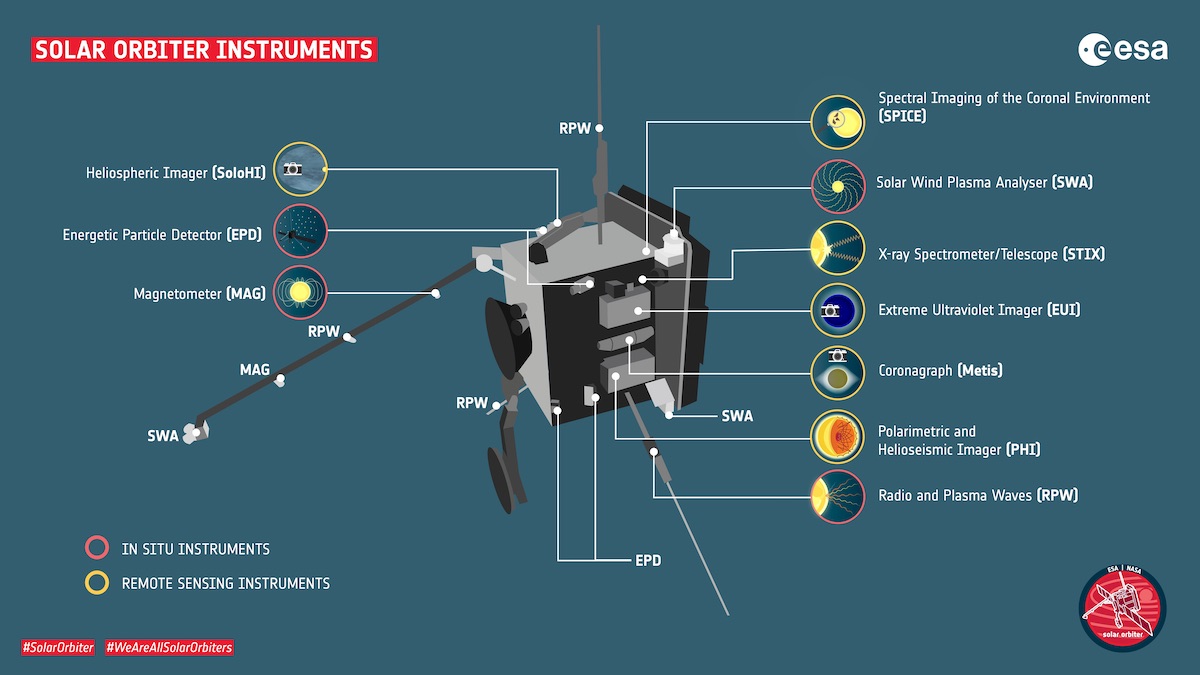
“What we want to do with Solar Orbiter is to understand how our star creates and (produces) this constantly-changing environment throughout the solar system,” said Yannis Zouganelis, ESA’s deputy project scientist for the mission. “We have big questions we want to answer.”
“There are still mysteries around our understanding of the energy sources in the sun that produces the magnetic field and solar flares,” Hasinger said. “A lot of people now think that some of the mysteries are actually hidden in the poles, which we have never seen. So the hope is that if we are able to observe the poles in a very accurate way, then we may understand better how the magnetic field is created and transported. In particular, the 11-year solar cycle seems to be linked to things that are happening on the poles.”
The Ulysses mission, thanks to a boost into a highly-inclined orbit from Jupiter’s gravity, carried instruments that measured the environment over the sun’s poles. But Ulysses did not have cameras, and it never flew closer to the sun than Earth.
Solar Orbiter will take around a half-year to complete one lap around the sun. At times, the spacecraft’s velocity relative to the sun will closely match the rate of the star’s rotation.
“So it’s almost like a geostationary satellite which always looks at the same spot of the sun for 10 days in a row,” Hasinger said. “That means you can really follow the development much more accurately and see how the magnetic field structures are developing.”
Scientists hope to learn more about the inner workings of stars by looking at the sun. But there’s also a tangible benefit, officials said.
“It is indeed a golden age for solar terrestrial physics,” Hasinger said. “It’s also, I think, an age where we are slowly moving from the scientific analysis to the understanding of space weather, and also space weather forecasting.
“So I think the whole element of space weather will become very important, not just for the environment of the Earth and the technical infrastructure, but also when you want to send astronauts to the moon and to Mars, space weather is a very important element,” Hasinger told Spaceflight Now.
Email the author.
Follow Stephen Clark on Twitter: @StephenClark1.






